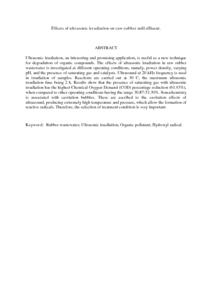Citation
Chua, Sze Yee and Abdul Latif, Puziah and Ibrahim, Shaharin
(2009)
Effects of ultrasonic irradiation on raw rubber mill effluent.
The IUP Journal of Environmental Sciences, 3 (3).
pp. 58-65.
ISSN 0973-9912
Abstract
Ultrasonic irradiation, an interesting and promising application, is useful as a new technique for degradation of organic compounds. The effects of ultrasonic irradiation in raw rubber wastewater is investigated at different operating conditions, namely, power density, varying pH, and the presence of saturating gas and catalysts. Ultrasound at 20 kHz frequency is used in irradiation of samples. Reactions are carried out at 30 C, the maximum ultrasonic irradiation time being 2 h. Results show that the presence of saturating gas with ultrasonic irradiation has the highest Chemical Oxygen Demand (COD) percentage reduction (61.83%), when compared to other operating conditions having the range 30.87-51.30%. Sonochemistry is associated with cavitation bubbles. These are ascribed to the cavitation effects of ultrasound, producing extremely high temperature and pressure, which allow the formation of reactive radicals. Therefore, the selection of treatment condition is very important.
Download File
![[img]](http://psasir.upm.edu.my/14426/1.hassmallThumbnailVersion/Effects%20of%20ultrasonic%20irradiation%20on%20raw%20rubber%20mill%20effluent.pdf)  Preview |
|
PDF (Abstract)
Effects of ultrasonic irradiation on raw rubber mill effluent.pdf
Download (83kB)
| Preview
|
|
Additional Metadata
Actions (login required)
 |
View Item |

